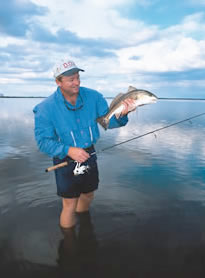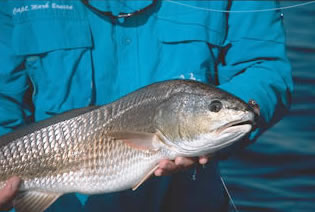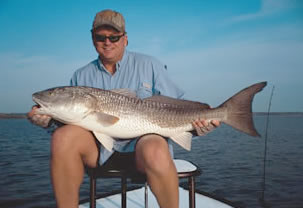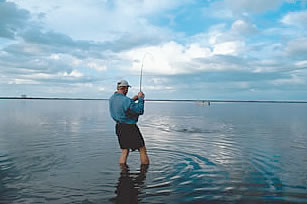February 01, 2006
By Tom Levine
Close to the ocean, but oh so far away.

Capt. Mark Benson's quiet approach weeds out a Mosquito Lagoon redfish. |
The thing is, reproduction in mammals is a self-contained product you can take anywhere, but redfish are sloppy, allowing their environment to play a major role in propagation. For example, like humans, redfish frequent oyster bars for social interaction. But if a lady redfish in a moment of weakness should let go her eggs right there, the preoccupied males would fail to notice and mother nature would not be served.
Redfish are particular about their salinity d'amore. The love medium must be sufficiently dense to float the released eggs above the bottom, where two or three male reds will attend them with milt. This response is triggered by either smell, sight or getting nudged in the ribs and winked at by a passing pigfish. In the oyster bar stage, the 3-to-1 male-to-female ratio holds for humans, demonstrating again the continuity of life.
This egg buoyancy requires higher salinity than the typical estuary can offer, so late August through October, reds forsake these bitty bars and head for the big ocean rave.
Except for the voluntarily landlocked redfish in that iconoclastic East Central coast waterworld, Mosquito Lagoon. They play by their own rules in this 25- by 2-mile anomaly and the redfish don't bother leaving to procreate, which results in a resident population almost as inert as the United States Senate. For this reason Mosquito Lagoon fanatic Capt. Mark Benson knows most of them personally.
“I want to introduce you to some of my friends,” he said, alluding to a congregation of reds he'd spotted.
“You don't have any friends,” I pointed out.
“There's Fred,” he said, ignoring me. “Fred's always up for tug-o-war. Watch this.” His topwater plug lightly splashed down about six feet in front of some tails. Sure enough, one twitch and a red ran out, clobbered it and started playing.
“I think they're all named Fred,” I mumbled.
“You're right,” Mark chuckled as his drag ran out like peanuts at an elephant party, “but this one's Fred Flintstone.
“Mosquito Lagoon is its own special place,” he rhapsodized, rod bent, clearly in love. “Just look at it. If you lived here would you ever want to leave?”
I gazed all around at the yellow fringed cirrus clouds of the morning sky scattered across the smooth lagoon surface, the early, rich sun on distant mangroves, storks winging overhead and scratched my ankle. “No, absolutely not. Where else could I find mosquitoes in such fabulous concentrations?”
The redfish probably don't know how lucky they are to live underwater. Many Central Florida placenames don't fit, like Altamonte Springs (no springs), Mount Dora (no dora) and Lake Wales (where's the wales?). But dusk to dawn you're not left wondering where in the heck Mosquito Lagoon got its name. Planing out of the boat ramp one summer night with Mark and an anti-mosquito suit with his buddy Charlie sweating inside it, I was inclined to ridicule Charlie, until we stopped. Soon there was little air between our mosquitoes. Drifting into a wind shadow, we practically drowned in them. Mark and I just constantly sprayed our hands, faces and my thin shirt. I was happy to see they even annoyed Charlie behind his screen. We got one hit, a smashing redfish strike to Charlie's floater at the boat. I think the fish glimpsed his suit and went insane.

Local captains intimately know the various redfish schools. Angler meets, greets and prepares to release his old acquaintance. |
Mark knows many of the different redfish schools and usually where to find them, recognizing the same exact fish. Students of the lagoon agree these home-loving redfish pretty much don't ever leave. Mosquito Lagoon reds are the first ever documented to spawn in an estuary, taking advantage of their home's unique characteristics. Where other estuaries are infused with fresh water, lowering their salinity compared to the ocean, Mosquito Lagoon's lack of dilution keeps it thick enough to buoy the eggs, even at its period of lowest salinity when the reds spawn, right after the rainy season.
One of my favorite things about the Lagoon is its eastern proximity to, yet isolation from the surf; to be fishing in this naturally serene giant cove with waves loudly crashing just out of sight, blocked by a little sand. After the morning mosquito bite, a fisherman could leave his boat, take a short hike and go body surfing. Geology indicates Mosquito Lagoon had a series of five inlets to the sea, the last of which closed about 1,500 years ago, or right about the time everything started being Bill Clinton's fault. These inlets may have set redfish on the course to becoming the population we see today.

Landlocked redfish schools are heavily fished and wary of boat anglers. Head 'em off on foot. |
Some scientists say reds got used to spawning in these passes and their homing instinct kept them doing it there after the passes had passed into the past.
Some say the reds simply appreciate the spawning-friendly salinity of the lagoon.
Senior Aquatics Scientist for a NASA subcontractor, Dr. Grant Gilmore, a man clearly preordained to study fishes for the government, thinks the passes probably were too shallow and unreliable as spawning areas and a process of natural selection may have taken place favoring reds that could do it anywhere.
The upper end of the Banana River is where the other couch potato reds hang out. From a helicopter Gilmore has seen 5,000 to 10,000 three-foot-plus reds congregated in the No-Motor Zone. “It was an awesome sight,” he says. North of the NASA Causeway they make their babies.
A genetic difference comparable to Red Sox versus Cubs fans is suspected between reds of the Atlantic Ocean and the Gulf of Mexico, and some researchers would like to show that the lengthy isolation of Mosquito Lagoon redfish has made them physically distinct. Gilmore finds this distinction likely and also thinks some outside reds may invade the Lagoon to mate, adding a little diversity like bottlenose dolphins are known to do or, again, country humans who head to the city each Friday night. He hopes to prove this cruising behavior soon by tracking offshore reds with new “acoustic tags” and seeing if one of them winds up in town.
When stalking Mosquito Lagoon redfish, there is the feeling that you really are entering their territory, not just a place these grazing fish are passing through like you on your way to traffic court. This is their hood and it's a lively one. In fact, a lot of fishing guides consider it their lively hood. And many others join them in hoping this one-of-a-kind backwater remains one of Mother Nature's enduring emblems.
Usually it goes like this. “Yep. There they are. You go that way and I'll go this way.”Mark continued to find schools of redfish in nooks and crannies because it's his territory, too. After we confirm the fish are there, it's a matter of slowly creeping up in the boat or sliding out, bottom permitting, and walking up on them. I often get the feeling they know we're here but they refuse to acknowledge our existence in their realm. This of course can lead to hookups.
“This way” always seems to hold the fish but I get enough action to keep my rod limber, not to mention the incidental ladyfish, seatrout and tarpon. Sometimes it's “Look at the size of that tail!” because there are some huge redfish living there, growing larger all the time, not leaving, just getting bigger, the only place in the hemisphere we can catch Mosquito Lagoon redfish.

Unlike other spawning populations that transition to offshore, high salinity allows Mosquito adult reds to procreate at home. |
A UNIQUE POPULATION OF RED DRUM
Redfish, red, red drum, channel bass and “Darn-it!” all refer to the same fish.
Male redfish drum when spawning. Further research will be needed to determine whether this is to attract mates or scientists, as it works equally well for both.
A lone drumming red sounds like a bongo player, a school becomes a steady hum. Traditionally hydrophones, a kind of underwater hearing aid, have been used to locate drumming drums. Acoustic sensors are a new product implanted into the abdomen of a fish which identifies him uniquely to the receiver with a range of about 300 yards of unobstructed water. Dr. Grant Gilmore hopes to attach receivers permanently to all the Indian River bridges, which will render a fascinating account of the travels of redfish and seatrout.
Redfish spawn between sunset and midnight. Gilmore thinks they could travel from as far as the Edgewater area to spawn in the south end of Mosquito Lagoon. This would allow six to seven hours to return by dawn, which is why many of these reds can be seen hailing a crab. With the introduction of acoustic tags, scientists have been shocked at the distances fish travel, including fish previously thought to be stay-at-homes. One snook went a mile in 20 minutes, then later returned.
To show how isolated is Mosquito Lagoon, other than Ponce Inlet to the north, the manmade Haulover Canal is its lone connection to the Indian River. Based on collection of eggs and larvae, a 1981 study indicates this canal played a major role in the redfish spawning. Gilmore's work and the observations of Mark Benson and others familiar with the Lagoon relegate the canal to a minor role in the present. Benson, however, to reconcile all the data, suggests the descendants of the original Lagoon reds are spawning at the south end of the lagoon and north of the NASA Causeway while newer residents from Ponce Inlet may be utilizing the modern canal. This could be proved with genetic testing of fish caught in the act at the different spawning sites.

Redfish takes angler for a walk. |
In tournaments, redfish caught in Mosquito Lagoon may ultimately be released somewhere in the Indian River, miles from their home, wherever the weigh station is. If these redfish are indeed an endemic subspecies, this practice should be reconsidered with the goal of not disrupting this special local phenomenon.
The many coves and harbors of Florida's west coast may see some redfish spawning in dredged channels but they are open to the Gulf of Mexico. Mosquito Lagoon is uniquely isolated.
Why identify breeding areas: Mosquito Lagoon redfish do not breed all over the place, but in specific spots. Pollution of one of these sites would devastate this unique population of fish.
On dumping freshwater canals into estuaries: Overflows into the St. Lucie River sickened saltwater fish such as snook and research shows that male seatrout stop calling females when salinity gets too low. If mating has already occurred, their larvae die.
FISH THE LAGOON
Lures: Topwater plugs and jerkbaits are exciting in the shallows as well as fly fishing streamers. Over sandy bottom spoons, jigs and rubber shrimp'll get ‘em. Cut or whole finger mullet are the best natural baits, often the only way to get a bit
e when the fish are finicky. Shrimp work, too, especially in winter.
Accessibility: There are ramps to launch boats into the Lagoon and roads such as Biolab Rd., to drive along until you see an enticing opening to wade out from or throw in a canoe or something. Canaveral National Seashore, on A1A south of New Smyrna Beach, has two launch ramps suitable for outboard skiffs; the southernmost (parking lot No. 5) is pretty good for wading, too. The unimproved Eddy Creek ramp in Playalinda Beach, just east of Titusville, is another dual-purpose access point, with hard bottom for waders. The Haulover ramp, accessed from State Road 3/Kennedy Parkway on the west side of the Lagoon, is very popular for boats of any size; the Haulover Canal links the Indian River and Mosquito Lagoon.
Sampling of Hotspots, South to North:
Whale Tail: Open-water flat near the very southern end of the lagoon, in the shape of guess what?
Cucumber Island: Some good redfish flats near this island on the east side.
Glory Hole: A shallow, grassy cut well into the east shoreline that fills up with redfish and skiffs.
Tiger Shoals: Mid-lagoon flat that holds schooling reds.
Georges Bank: A long, east-west sandbar west of the southern Canaveral Seashore ramp, along the last bit of open water at the north end of the lagoon.
More Spots: Check out Florida Sportsman Chart No. 04. Fishing Florida's Space Coast , by occasional FS contributor John Kumiski, is another great resource (
www.spottedtail.com).
Which Isn't True
1. There's no bizness like showbizness.
2. All dogs go to heaven.
3. All redfish spawn in ocean inlets.
If you're stumped, we'll examine them individually:
1. Take one look at Meatloaf and you know that's true.
2. Of course they do.
3. Must be this one.
Could be you never thought much about it one way or other ways. Humans spawn in an endless variety of locations, including the ocean. Why should redfish be any different?
FS
